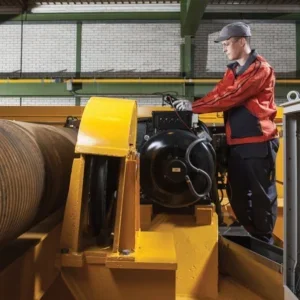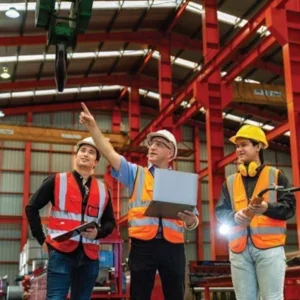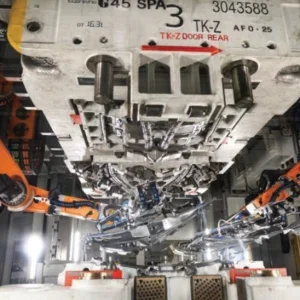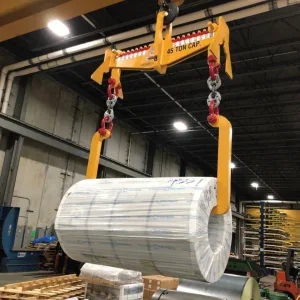The industrial crane industry in India has enjoyed strong growth on the back of the country’s economic development in recent years. Demand has slowed somewhat this year, but the underlying picture continues to be one of growth, with the downside offset by government investment in infrastructure projects.
Balraj Goel, managing director of crane and hoist manufacturer Reva Industries, says: “The global economic downturn has affected every country. Fortunately in the crane and hoist sector there is healthy growth, mainly because of government policies for infrastructure. This trend is likely to continue.”
Goel says Reva’s strongest end user market is the power sector and associated industries, and here demand remains undimmed,. Goel expects Reva’s turnover to reach INR200 million (USD3.94m) in fiscal 2008/09, up from INR120 million in 2007/08. He is targeting the steel industry to maintain this growth. “We had no presence in the steel sector until now. Although we are a late entrant, we hope to gain a good foot-hold in the next six months. Our target is to achieve INR275 to 300 million in 2009/10.”
AC Heri, managing director of crane builder Armsel, says, “We are holding orders on hand from time bound projects for 9-10 month periods, we should be able to confidently manage this period, which may extend at least for another year.
“As our manufacturing capacity is only around 5% of the total demand, we have managed to keep our facilities busy so far. We are continuing at the same pace and are achieving an average 20% growth rate every year.”
Heri continues: “In 2004/05 our sales turnover was INR85 million (USD1.67m). We have had a steady average growth rate of more than 35%. This year we expect turnover of INR270 million, three times 2004/05. Forecasts for 2009/10 turnover would be around INR340 million.”
Tushar Mehendale, managing director of crane builder ElectroMech, says, “In the global downturn, India and China are going to emerge as the main markets for the global industry due to sustained growth in their economies. A lot of action is taking place in India in almost all sectors. We are exclusively in the industrial cranes segment, with the majority of cranes falling in the SWL range of 1-150 tonnes. We cater to a vast range of industry verticals
“Given the chronic lack of infrastructure in India, there is a sustained boom. With the government intending to prime up the economy by boosting spending on infrastructure, we expect a lot of new projects to come online. There has always been a huge gap between the demand and supply of electricity across India. A lot of new power projects are being implemented, and ancillary industries are developing at an accelerated pace.”

Mehendale (pictured, above) says ElectroMech manufactured 385 cranes in 2006/07, 457 in 2007/08 and, speaking before the 31 March year end, is set to make close to 650 cranes in 2008/09: “On a top line basis, our growth for the current financial year is 87.5%.”
Mehendale says two factors conspired against India in 2008. Due to sustained high growth rates in the past few years, there was runaway inflation. In response, the Reserve Bank of India started tightening money supply in the first quarter of 2008/09. This pushed interest rates up. Inflation was coming under control by September 2008, but the global financial meltdown led to another crisis and banks suddenly stopped lending. A lot of projects got put on hold and demand nosedived. Now the liquidity situation in India is much better with Indian banks, Mehendale says.
“We had got a lot of orders for projects which were planned much before and had their financial closures in place,” Mehendale says. These projects were already set into execution long before any financial turmoil, and have now reached a stage where they have to be completed. Order backlog from these continues to fill ElectroMech’s capacities for the next few months.
Mehendale says today is a great time to set up a project in India as steel prices are at a low and project costs have come down. After a big dip in order finalisations, “we are slowly seeing some recovery and new orders are being finalised. We will see some tempering in 2009 with a full fledged recovery expected around end of 2009.”
A fragmented industry
The overhead crane industry is highly fragmented, with approximately 120 crane builders active across India, although only about 10% are national players, says Armsel’s Heri.
ElectroMech’s Mahendale says: “Typically each industrial area in India will have at least a couple of crane manufacturers. About 15 companies operate across the country, while the rest have their own pockets of operation. Some concentrate only on the niche area of heavy duty cranes. Some specialise in supplying only certain end users like railways or defence. There are a lot of opportunities for consolidation and companies like ElectroMech are always on the prowl for good acquisition targets.”
When it comes to hoist production, there is even more fragmentation. Goel says Reva is one of more than 200 companies that manufacture hoists and collectively account for 80% of all electric hoists purchased in the country.
Heri says imports account for no more than 15% of the market. Armsel is a distributor of the German manufacturer SWF, part of the Konecranes group, and regularly uses SWF crane kits. “Overseas manufacturers have done reasonably well in recent years,” Heri says. “Their success has been mainly in the automobile sector and ancillary units. In other general engineering sectors customers have preferred imported cranes. This happens mainly in multinationals where the customer has already been exposed to such suppliers.”
ElectroMech imports hoists and kits from Abus in Germany. Mahendale believes imports account for less than 10% of electric hoist consumption, considered in isolation from cranes.
Of the European manufacturers, there is a consensus that Demag leads the way with a market share of 45% of imports, followed by fellow Germans Abus and Stahl, with around 20% each.
Demag’s leadership is at least partly attributable to its early entry. Previously represented by an agency, Demag set up a fabrication subsidiary in July 1997 in Pune in western India, home to a large concentration of industrial end users and the main centre of engineering in India. Companies like Volkswagen, Daimler, Nissan and Tata Mahindra & Mahindra all have production plants in Pune, which is just 100km or so from Mumbai, the country’s financial centre.
Demag generally builds cranes in Pune, where it has 160 employees, using component kits shipped from Germany. Recent notable contracts include projects for Renault Nissan Automotive and Tebma Shipyard, both based in Chennai in the south, and Bombardier in Gujurat to the west.
As well as selling hoists and crane kits to distributors through its Stahl and SWF operations, Konecranes now operates in India as a crane builder in its own name. Konecranes set up a subsidiary in Pune in February 2007, shortly after securing a EUR10 million contract for four hot metal ladle cranes from one of the country’s leading steel producers, Bhushan Steel & Strips.
Over the past two years, it has grown rapidly, says country manager Sami Korpela. “We started with service and standard lifting sales and now offer all group products and services throughout India. We have six branch offices/service locations in India and approximately 100 employees.” Konecranes has won contracts from companies such as Tata Motors and General Motors. Last year, under one contract alone, it delivered 173 cranes to wind turbine producer Suzlon Energy.
Chinese producers have yet to make any impact on the powered hoist industry. “Chinese manufacturers are mostly catering to the manual hoist business,” Reva’s Goel says.
Crane technology
European manufacturers tend to compete in a different market from local manufacturers. Relatively few end users want, or will pay for, the technology European builders offer. A typical five tonne SWL European-made hoist costs four times as much as an Indian-made one, Mahendale says: “The main buyers of these hoists are small factories and workshops: up-front price becomes very important.”
While Indian standards are closely aligned to European and American standards, the roots of the industry lie in old Soviet technology, Mahendale explains: “The newer Indian standards for the cranes are more and more aligned to FEM/BS standards. Indian standards were pretty conservative, leading to massive over-engineering. Today, standards are not as detailed as FEM, but there are a lot of improvements.
“The current Indian crane industry can trace its roots to the USSR. Soon after independence, the Indian government put in place a lot of industrialisation projects with the main thrust being in the steel and allied heavy engineering industry. Since at that time India was more favourably inclined towards the USSR, a lot of agreements were signed between the two countries. The USSR helped India set up a lot of steel plants and other allied heavy engineering facilities. The Russians handed over detailed manufacturing drawings and design calculations for all the equipment supplied by them, including cranes.
“A few enterprising people managed to secure these drawings and calculations and started manufacturing cranes in the private sector. Soon people from these companies, after getting the necessary experience, branched off and started their own businesses. This led to a cascading effect, with the majority of crane manufacturers in India tracing their roots to Russian designs.
“The Indian industry is most conversant with this typical old, open winch, type of heavy design. Rightfully, such design was used on steel mill duty cranes. However, the same set of specifications found their way in to simple workshop duty cranes as well. If you go to almost any factory in India, you will invariably find brand new cranes manufactured to old Russian standards. These designs are simple and no special skills or investments are required to manufacture cranes confirming to them. I believe India must be the only country in the world (apart from China, most likely) to have so many crane manufacturers.”
Market size
Statistics about the total size of the crane and hoist market in India are hard to be certain about, but educated assessments are willingly offered.
Heri cites a survey that puts the value of the EOT crane market in India in the year 2008/09 at around USD400 million.
“It is very difficult to put an exact figure,” says Mahendale, “But we have estimates. The figure of around 10,000 cranes annually for the Indian market is reasonable. This market was projected to expand at 15-20% every year when the economy was growing. In the current scenario, growth will be a bit tempered.”
Mahendale says close to 30% of all cranes are purchased by public sector organisations. ElectroMech focuses only on the private sector. “The private sector is the most vibrant part of the Indian economy and growing at a huge pace and willing to adopt to newer technologies much earlier,” he says. Of the 7,000 cranes a year reckoned to be purchased by the private sector, he says, “roughly 30%” are manufactured and sold by what he calls “the unorganised sector, for example, general purpose contractors/fabricators who have no proper technical knowledge about cranes, and rely more on copying existing cranes and ‘rule of thumb’ designs.
“This boils down to about 4,900 cranes in which the organised sector competes. Of these 4,900, roughly 15% cranes will be technological cranes used in process industries and the remaining 85% are standard workshop duty cranes. The market for standard cranes is potentially 4,200 cranes a year in the private sector. The share for European cranes is roughly 25%, or almost 1,000-1,100 cranes a year.”
Of the 650 or so cranes that ElectroMech made in 2008/09, roughly a third were Abus cranes. Mahendale concludes that, while other crane manufacturers that specialise in large process cranes, such as Mukand and Anupam, may have a higher sales turnover, “this makes us the largest manufacturer of cranes in India in terms of volumes”.






